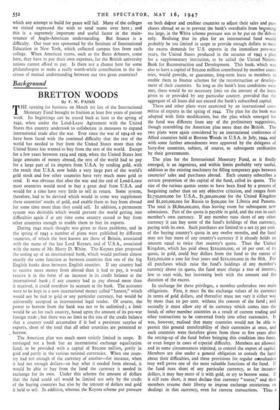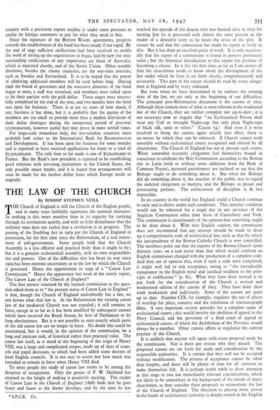Background
BRETTON WOODS
By F. W. PAISH
THE opening for business on March 1st last of the International Monetary Fund brought to fruition at least five years of patient work. Its beginnings can be traced back at least to the spring of 1942, when under the Lend-Lease Agreement with the United States this country undertook to collaborate in measures to expand international trade after the war. Ever since the war of 1914-18 we have been faced with the continual difficulty that the rest of the world has needed to buy from the United States more than the United States has wanted to buy from the rest of the world. Except for a few years between 1924 and 1929, when the United States lent large amounts of money abroad, the rest of the world had to pay for a large part of its imparts from U.S.A. by sending gold, with the result that U.S.A. now holds a very large part of the world's gold stock and few other countries have very much more gold to send. It was obvious that after the war and the end of Lend-Lease most countries would need to buy a great deal from U.S.A. and would for a time have very little to sell in return. Some system, therefore, had to be devised which would in some way supplement these countries' stocks of gold, and enable them to buy from abroad for some time more than they could sell. In addition, a permanent system was desirable which would prevent the world getting into difficulties again if at any time some country ceased to buy from other countries enough to enable them to buy its exports.
During 1942 much thought was given to these problems, and in the spring of 1943 a number of plans were published by different countries, of which the best known are those of Britain, associated with the name of the late Lord Keynes, and of U.S.A., associated with the name of Mr. Harry D. White. The Keynes plan proposed the setting up of an international bank, which would perform almost exactly the same function as between countries that one of the big English banks does between English counties. If any country had to receive more money from abroad than it had to pay, it would receive it in the form of an increase in its credit balance at the international bank ; if any country had to pay abroad more than it received, it could overdraw its account at the bank. The accounts were to be kept in a new international money called " bancor," which would not be tied to gold or any particular currency, but would- be universally accepted as international legal tender. Of course, the power to borrow from the bank was not to be unlimited ; a limit would be set for each country, based upon the amount of its pre-war foreign trade ; but there was no limit to the size of the credit balance that a country could accumulate if it had a persistent surplus of exports, short of the total that all other countries are permitted to borrow.
The American plan was much more strictly limited in scope. It envisaged not a bank but an international exchange equalisation fund, to be provided with a capital of $to,000 million, partly in gold and partly in the various national currencies. When one coun- try had not enough of the currency of another—for instance, when it had not enough dollars—to buy what it needed from abroad, it would be able to buy from the fund the currency it needed in exchange for its own. Under this scheme the amount of dollars that the fund could sell would be limited not only by the credit of the buying countries but also by the amount of dollars and gold it held to sell. In addition, whereas the Keynes scheme put pressure
on both debtor and creditor countries to adjust their sales and pur- chases abroad so as to prevent the bank's overdrafts from beiorning too large, in the White scheme pressure was to be put on the debtor only. Realising that its plan for an international fund would probably be too limited in scope to provide enough dollars to meet the excess demands for U.S. exports in the immediate post-war years, the United States produced in the autumn of 1943 a plan for a supplementary institution, to be called the United Nations Bank for Reconstruction and Development. This bank, which was also to have a capital of $to,000 million contributed by member coun- tries, would provide, or guarantee, long-term loans to members to enable them to finance schemes for the reconstruction or develop- ment of their countries. So long as the bank's loan conditions were met, there would be no necessary limit on the amount of the loans given to or provided by any particular country. provided that the aggregate of all loans did not exceed the bank's subscribed capital.
These and other plans were examined by an international com- mittee of experts in the spring of 1944. The plan for the bank was adopted with little modification, but the plan which emerged for the fund was different from any of the preliminary suggestions, though resembling the American plan more than the British. The two plans were again considered by an international conference of Allied countries held at Bretton Woods in U.S.A. in July, 1944, and with some further amendments were approved by the delegates of forty-five countries, subject, of course, to subsequent ratification by their governments.
The plan for the International Monetary Fund, as it finally emerged, is an ingenious, and within limits probably very useful, addition to the existing machinery for filling temporary gaps between countries' sales and purchases abroad. Each country subscribes a certain proportion of the capital of the fund, called its quota. The size of the various quotas seems to have been fixed by a process of bargaining rather than on any objective criterion, and ranges from $2,75o,000,00o for U.SA., $1,3oo,00o,00o for the United Kingdom and $1,200,000,000 for Russia to $5oo,000 for Liberia and Panama. The total is $8,800,000,000, thus leaving room for subsequent new admissions. Part of the quota is payable in gold, and the rest in each member's own currency. If any member runs short of any other currency it can buy some of the fund's holdings of that currency, paying with its own. Such purchases are limited to a net 25 per cent. of the buying country's quota in any twelve months, and the fund may not buy more of any country's currency if it already holds an amount equal to twice that country's quota. Thus the United Kingdom, which has paid about $21o,doo,00o, or 16 per cent. of its quota, in gold, could buy dollars from the fund to the extent of $325,000,000 a year for four years and $21o,000,000 in the fifth. For all purchases which raise the fund's holdings of any member's currency above its quota, the fund must charge a rate of interest, low to start with, but increasing both with the amount and the duration of the excess.
In exchange for these privileges, a member undertakes two main obligations. First, it must fix the exchange values of its currency in terms of gold dollars, and thereafter must not vary it either way by more than to per cent. without the consent of the fund ; and secondly it must allow any of its currency which comes into the hands of other member countries as a result of current trading and other transactions to be converted freely into other currencies. It was, however, realised that many countries would not be able to permit this general transferability of their currencies at once, and such countries were therefore given from three to five years after the setting-up of the fund before bringing this condition into force, or even longer in cases of especial difficulty. Members are allowed, and in some circumstances enjoined, to control the export of capital. Members are also under a general obligation to consult the fund about their difficulties, and these provisions for regular catisultation may well prove one of the most valuable functions of the fund. If the fund runs short of any particular currency, as for instance dollars, it may buy more of it with gold, or try to borrow some. If it still runs short, it must declare that currency "scarce," and then members resume their liberty to impose exchange restrictions on dealings in that currency, even for current transactions. Thus a
country with a persistent export surplus is under some pressure to enable its foreign customers to pay for what they need to buy.
Since the signature of the Bretton Woods agreements, progress towards the establishment of the fund has been steady if not rapid. By the end of 1945 sufficient ratifications had been received to enable the work of setting up the organisation to begin, 'and by now the only outstanding-ratifications of any importance are those of Australia, which is expected shortly, and of the Soviet Union. Other notable absentees, besides the enemy countries, are the war-time neutrals, such as Sweden and Switzerland. It is to be hoped that the power of admitting additional members will be used before long. During 1946 the board of governors and the executive directors of the fund began to meet, a staff was recruited, and members were called upon to fix their parities with the gold dollar. These stages were success- fully completed by the end of the year, and two months later the fund was open for business. There is as yet no news of how much, if any, business it has done, but it is probable that the quotas of the members are too small to provide more than a modest alleviation of their dollar shortages during the exceptional period of post-war reconstruction, however useful they may prove in more settled times.
For large-scale immediate help, the war-stricken countries must probably look rather to the International Bank for Reconstruction and Development. It has been open for business for some months and is reported to have received applications for loans to a total of $2,300,000,000. The only loan so far made is one of $250,000,000 to France. But the Bank's new president is reported to be establishing good relations with investing institutions in the United States, the only possible major lender, and it is hoped that arrangements will soon be made for the further dollar loans which Europe needs so urgently.



































 Previous page
Previous page